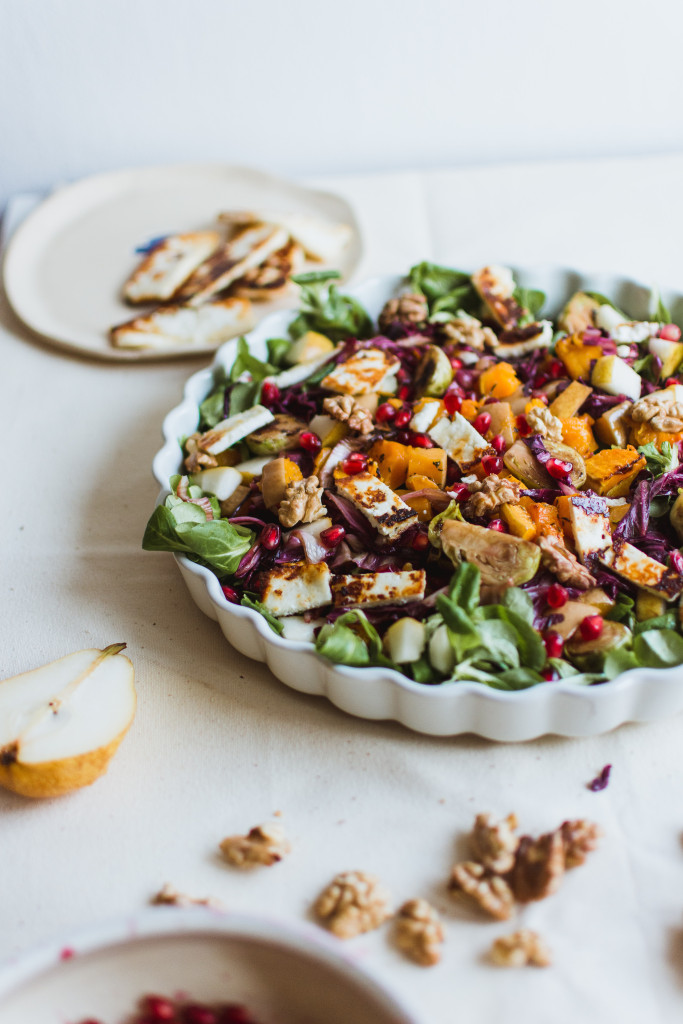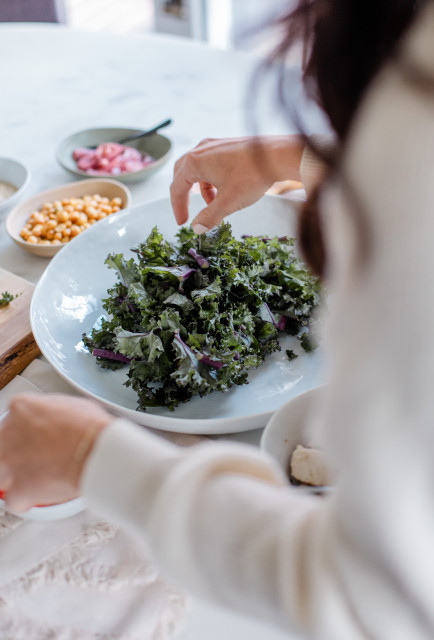
The Ultimate Guide to the Low-FODMAP Diet
Confused about this increasingly popular plan? Wondering if it might help your gas, bloating, or other GI woes? Read on.
If you follow nutrition news and diet trends, there’s a good chance you’ve heard about the low-FODMAP diet. That’s because it’s one of the most well-studied interventions and one of the most common recommendations made by GI doctors when someone comes in with symptoms like gas, bloating, diarrhea, constipation, and abdominal pain. In fact, up to 86 percent of patients with IBS find improvements in their gastrointestinal symptoms when following this diet.
While a low-FODMAP diet can work wonders, it’s important to realize that it’s not a long-term lifestyle change. I usually prescribe a six-week protocol, which is typically long enough to give GI symptoms time to improve.
Wondering what a low-FODMAP diet is—and whether it’s right for you? Read on.
What is FODMAP?
It’s an acronym that stands for a group of carbohydrates (Fermentable Oligosaccharides, Disaccharides, Monosaccharides, and Polyols) that are fermented by the gut bacteria in your intestine. In a healthy gut environment, this fermentation process is a good thing. But for someone who has digestive distress or bacterial overgrowth, it can lead to accelerated fermentation, which can cause bloating and other GI symptoms.
What are some foods that fall into these categories?
Oligosaccharides are fructans (chains of fructose sugars) and GOS (chains of galactose sugars). Foods high in oligosaccharides include:
- Grains like wheat, barley, and rye. Some people who experience adverse symptoms from gluten may have difficulty processing foods high in FODMAPs. Gluten-containing foods, such as wheat, are high in fructans. Some studies have shown that people who believe they have gluten sensitivities actually may have difficulty processing the fructans that are present in gluten-containing foods.
- Some vegetables, such as artichokes and alliums, like garlic, onions, and leeks.
- Some nuts and legumes, including lentils and chickpeas.
Disaccharides are foods containing lactose, such as milk, ice cream, yogurt, sour cream.
Monosaccharides are foods that contain fructose, such as fruits, some veggies (asparagus), and sweeteners, such as agave syrup, honey, high-fructose corn syrup.
Polyols are sugar alcohols, which includes things that are added to products and several foods that naturally have sugar alcohols in them, including:
• Fruits like apples, blackberries, peaches, and plums.
• Vegetables like cauliflower, mushrooms, and snow peas.
• Sorbitol, mannitol, malitol, and xylitol.
Why are FODMAPs An Issue For Some People?
If you have bacterial overgrowth, foods high in FODMAPS can lead to rapid fermentation in the colon, which produces gases such as hydrogen, carbon dioxide, and methane. That in turn creates abdominal distention, abdominal pain, and uncomfortable flatulence.
These short-chain carbohydrates will tend to be poorly absorbed in your small intestine. If a person has small intestinal bacterial overgrowth (SIBO), which can contribute to irritable bowel (IBS) symptoms, the bacteria in the small intestine will ferment these carbohydrates and increase gas production. In those who do not have SIBO, these carbohydrates move on to and get absorbed in the colon, where they are fermented and can have an osmotic effect, creating an imbalance of water in your large intestine.
The most common symptoms that people have before they create a healthier gut microbiome are gas, bloating, diarrhea, constipation, and abdominal pain. Because the symptoms vary so much, I suggest working with a dietitian or a health care practitioner who can identify whether FODMAPs might be an issue. You may have general IBS symptoms, but often a root cause of IBS is SIBO, dysbiosis, food sensitivities, or a leaky gut.
Several randomized controlled trials have demonstrated that those who have IBS and follow a low-FODMAP diet are more likely to experience reductions in pain and bloating, compared to those following a traditional diet.
When to Consider a Low-FODMAP Diet
A low FODMAP diet is best when you have ongoing GI Symptoms such as diarrhea, bloating, and abdominal pain that does not seem to improve with other interventions. It's been shown in research to be beneficial for individuals with IBS, inflammatory bowel disease and other gastrointestinal issues. This would especially be true if increasing your intake of vegetables makes your symptoms worse, if specific foods such as garlic, onions, apples and cauliflower seem to make your symptoms worse.
When I’m working with someone, my recommendations are based on the individual, their lab work, and their current diet. Some people may benefit from starting with removing processed foods from their diet, decreasing added sugar consumption, and working on stress management—all of which can support a healthy microbiome. People can experience significant outcomes from those initial interventions alone. For others, their GI symptoms could be caused by sensitivities to foods like gluten and dairy that are unrelated to FODMAP consumption.
For people who already have a healthy diet and are reporting ongoing bloating that isn’t tied to any particular food, you may want to begin to explore whether foods high in FODMAPs seem to be a potential trigger. When someone comes in saying they eat a lot of raw vegetables, garlic and onion, fruits, fats like avocado, beans, and some grains, that’s a flag for me. So is a course of antibiotics before someone’s symptoms began, which can indicate that someone’s gut microbiome is out of balance.
Also keep in mind that although GI symptoms are most common in those who have gut imbalances, the health of your gut impacts many metabolic, inflammatory, autoimmune, mood, and cognitive processes. Gut disturbances could also manifest in autoimmune disease, brain fog, poor concentration, poor memory, depression, and anxiety.
How Long Does Someone Typically Follow a Low-FODMAP Diet?
The general recommendation is a 3-6 week period without high FODMAP foods in the diet. After that time, a gradual reintroduction process is used. My clients have the greatest success when pairing the diet with the right supplements to help create a healthier microbiome.
You don’t want to follow a low-FODMAP diet longer than necessary because we need FODMAPs in our diet. FODMAPs are extremely helpful for the gut microbiome—they feed your bacteria. A low-FODMAP diet reduces the amount of prebiotics that a person has in their diet, which in turn lowers beneficial short-chain fatty acids and has been associated with lower levels of Bifidobacterium species (good bugs!) after just two to four weeks. If a person removes FODMAPs from their diet for a year because they’re experiencing improvements in their symptoms, it will also decrease the diversity of the microbiome, which may not be beneficial in the long term.
So, What Can You Eat on a Low-FODMAP Diet?
While there are several foods that are more limited on this diet (read: allium veggies, fruits, dairy, legumes, grains, and sweeteners) there are still plenty of nutritious options:
- Fruits like blueberries, raspberries, strawberries, banana, rhubarb, lemons, limes, and oranges.
- Vegetables like arugula, Swiss chard, collard greens, bok choy, carrots, kale, lettuce, spinach, and squash.
- Black, brown, and wild rice.
- Milk substitutes, such as nut milks and coconut milk.
- Nuts and seeds like Brazil nuts, macadamia nuts, pecans, walnuts, chia seeds, and pumpkin seeds.
- Oils, such as avocado oil, extra virgin olive oil, and some coconut oil.
- Protein like wild salmon, organic chicken, turkey, eggs, grass-fed beef, and organic tofu.
For more support figuring out what to eat (or not) when following a low-FODMAP diet, the Monash University app is helpful. A group of PhD researchers at Monash University developed the low-FODMAP diet, and they’ve been conducting research on it for more than a decade! The app includes a list of foods that you can click on to find out how high the food is in FODMAPs at different serving sizes, allows you to track what you’re eating, and has a ton of great recipes.
Typically, my patients following a low-FODMAP diet and the right supplement protocol notice improvements in their GI symptoms slowly and gradually. This is really important to understand! I can’t tell you how many people who come to see me expect that nutritional interventions will help them go from feeling horrible to amazing overnight. That’s just not the case.
That said, odds are overwhelmingly high that you will feel better. It’s rare for people not to experience improvements in their symptoms. If that does happen and a low-FODMAP protocol isn’t giving you results, I recommend working with a functional practitioner and asking for further testing.
I know that understanding FODMAPs and figuring out if following a low-FODMAP diet might be right for you can be challenging! If you want to better understand whether foods high in FODMAPS might be causing your GI woes, schedule a free 15-minute consult to see if My Food Is Health program—the ultimate approach to personalizing nutrition and lifestyle and learning what works best for your body—might be a good fit for you. Registration is open now for a limited time.



